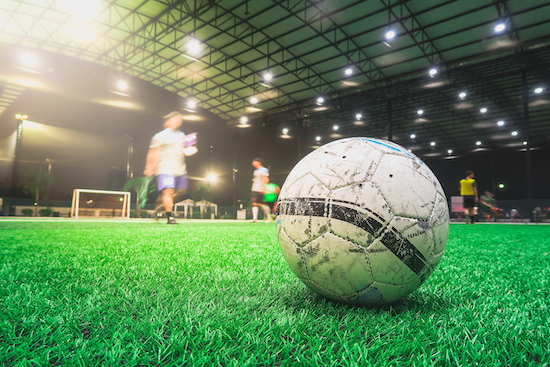With so many more soccer games being played on turf, does your child need to switch from cleats to turf shoes this season? Find out what the best choice is for your player and why it matters.
In recent years, turf fields have become increasingly popular in communities because of their lower maintenance costs and increased durability. As a result, many athletic fields that were once grass have been converted to turf. You can see the change at parks, community centers, and schools all over the country.
The problem is that soccer cleats, the default choice of many youth players, were designed to be worn on grass fields. The same features which make cleats a safe choice on natural grass have the opposite effect on turf.
How Cleats Work
The studs on cleats are designed to dig into and actually penetrate the ground on impact in order to provide traction. When playing on grass, this helps players avoid slipping. By having fewer studs that are spaced out, players get better mobility and speed because the cleats don't accumulate mud and grass.
How Turf Is Different
When you look at those parts of a turf field and how a player's feet comes into contact, it's easier to understand why cleats don't work.
Synthetic fibers are the top layer of a turf field. The fibers are the part that resembles grass and they come in different widths and lengths.
Turf infill surrounds the base of the grass-like fibers and is made up of fine, dense particle materials which are meant to support the turf blades and provide shock absorption. Commonly used materials include granulated crumb rubber produced from used tires, flexible plastic pellets, sand, and rubber-coated sand. Whatever it's made from, some of it will probably come home in your player's shoes.
Backing serves as a base or foundation for the synthetic “grass,” which is “tufted” to it - another way of saying it's very firmly attached. While you may not be able to see the base, you can feel it if you dig your fingers in the turf.
Cleats are designed to dig into the earth, not synthetic turf. Cleats don't release as easily from the carpet-like structure of synthetic blades which can cause the studs to get stuck and lead to ACL injuries.
The most obvious difference between cleats and turf shoes is in the studs. While cleats have fewer and longer studs on the heel and front of the foot, the bottoms of turf shoes are covered with dozens of shorter studs placed close together. These little studs provide traction for players on turf. A less obvious difference is that turf shoes also have harder outsoles than traditional soccer cleats to better withstand the impact on turf.
Added Safety Benefit
Is It Okay to Wear Cleats on Turf?
Unless the facility has a policy against it, traditional hard surface cleats can be used on most artificial turf fields. Spikes, however, should not be worn as they pierce the ground and can damage the synthetic grass. If your child will be playing on artificial turf frequently, you should invest in turf shoes.
Is It Okay to Wear Cleats on Turf?
Unless the facility has a policy against it, traditional hard surface cleats can be used on most artificial turf fields. Spikes, however, should not be worn as they pierce the ground and can damage the synthetic grass. If your child will be playing on artificial turf frequently, you should invest in turf shoes.
What About Indoor Soccer?
As noted above, it's best to go with turf shoes for indoor soccer.

